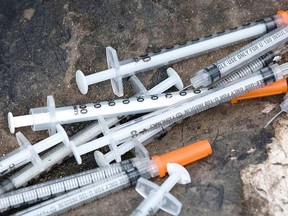Article content
The number of people in London and surrounding Middlesex County dying from opioids remained “shockingly high” in 2023, public health officials say.
The numbers are preliminary, but the death count stood at 102 for last year, according to figures from the Middlesex-London health unit.
That’s down from peak years of 2022 and 2021 and back to the same level as the first year of the pandemic in 2020.
Article content
“We are talking about still shockingly high numbers of people dying, who are otherwise pretty young and otherwise should not be dying,” Dr. Alex Summers, the medical officer of health, said.
The drop from 124 deaths in 2022 to 102 in 2023 brought little relief to health professionals in the thick of battling the opioid crisis.
“Every single death is too high. If you’re looking at a population level, we’re not winning,” said Dr. Andrea Sereda at London InterCommunity Health Centre.
Sereda runs the safer opioid supply (SOS) program in London, which provides pharmaceutical hydromorphone to 278 patients addicted to opioids. The program aims to replace street drugs with safer drugs and improve people’s health.
Although research has shown the SOS program improves the health and lives of patients, the issue has become politicized by federal Conservative Leader Pierre Polievre and his supporters.
Opponents to safe supply say it is fueling addiction and the opioid crisis by providing drugs that are diverted to the street. Money used for safe supply should be used for treatment, critics say.
Article content
But Sereda points out that in London, the SOS program serves about 4.6 per cent of an estimated 6,000 injection drug users in the city. That estimate was made in 2017 and should be higher now, she said.
“So 4.6 per cent of people who could benefit from safe supply are able to receive it. That’s a drop in the bucket. The other 95 per cent of people are at the mercy of the volatile and constantly changing street supply,” Sereda said.
“We don’t have enough of safe supply to turn the tide. Deaths are going up every year in every single province because there are far more people who use fentanyl than there are physicians and nurse practitioners who can help with an intervention.”
The rise in overdose deaths comes with the onslaught of fentanyl – a synthetic opioid up to 100 times more powerful than morphine – and the increasing variety and levels of other dangerous chemicals in street supplies, Sereda said.
“Every six months to 12 months, we’re getting a new cut that’s even more volatile and dangerous,” she said. “The street supply is unpredictable. One week you’ve got eight per cent fentanyl and the next week two per cent fentanyl.”
Article content
A baseline of 100 deaths a year is unacceptable, Summers said.
“It almost leads into a false sense that things are OK, when high becomes your baseline. When the baseline is still preventable deaths, that’s still a problem that we need to talk about,” he said.
The debate over harm reduction is creating a divide that should not exist, Summers said.
“Harm reduction is a critical component of a comprehensive approach to reducing the harms associated with drugs. As is treatment. These are not competing things,” he said.
“At the local level we’re still working well to not allow that division to be the cornerstone of our discussion around the solutions to this crisis. We’ve got lots of committed community organizations and leaders, and people with lived experience showing us the way.”
Opioid related deaths in London
2017: 34
2018: 64
2019: 60
2020: 102
2021: 129
2022: 124
2023 (preliminary): 102
Share this article in your social network













